The Art of Twister

Subject: Visual Arts
Grade: 8th
Teacher: Ana Cristina Esteves
Date: 23rd April 2018
Summary: Revision of 7th grade contents:
- colour scheme
- construction of regular polygons
- Module/ Pattern
- Methodology of design
Learning aims:
- Identify polygons
- Create a circle of colours
- Name primary, secondary and third colours
- Label warm or cold colours
- Recognize types of patterns
- Identify modules inside patterns
- Term design types
- Point out the differences between handcrafted and design products
Assumptions: The students are already familiar with the contents listed above as they studied them in the 7th grade.
Strategies/procedure:
Preparation: The teacher makes a Twister Rug and a spinner and prepares a quiz of four decks of colours. Each deck has a different colour for each subject matter revised during the lesson:
- Blue for colour scheme
- Red for polygons
- Yellow for Module/ Pattern
- Green for Methodology of design
The class is divided into 4 groups and each group will be identified with a colour. The teacher uses the spinner to establish the colour order in which the game is played.
Only one member of each team can be on the rug at once. One student from each team places him/herself on the Twister rug on the circle with their team’s colour. After one player falls, he is replaced by another team member and the game goes on until there is only one player on the rug.
First team to play uses the spinner to see what colour card they answer to. The teacher picks a card from one of the decks according to the colour and reads the question aloud and the team is given 30 seconds to answer.
If the team answers correctly, they can choose to place their hands or feet in the position they want on the twister rug. If they answer incorrectly, they are obliged to place their hands or feet in the position assigned by the spinner.
The goal is to not fall and make it harder for their opponents to keep their positions on the rug. The winning team is the team that still has a player on the rug.
SWOT ANALYSIS:
Strengths:
- The game enables the teacher to revise the contents needed in a funny way
- stimulation of team work
- Engagement of the inhibited students
- promotion of teamwork and cooperation
- Motivated way of revising theory
- inclusion of students with SEN
Opportunities:
- Pupils are usually acquitted with the game
Threats:
- Time to prepare and make the resources (the quiz, the Twister rug and spinner)
Game: Simon says...
English Teacher: Daniel Fischer – Gemeinschaftsschule Bruchwiese - Germany
Grade: 8th ; level A2.1 – class 8.3, 18 students (3 with …)
Date: 27th November 2017 (45 minutes)
Overall objective: The game is based on the idea of Total Physical Response (or TPR) Your students are not just listening to English and memorizing the words, they are totally involved in assimilating the language through movement and response.
Pedagogical objective: develop skills – listening and speaking - your students will learn these words and phrases very effectively and very well. They are not in the classroom learning English, they are in the classroom playing a game and the hidden (to them) side-effect of this game is that they will learn English.
Educational Objective: improve communicative competence in English
Description of activity / scenario
The game is simple. You, as teacher, give commands to your class using “Simon says” to introduce the commands. You say and the students follow:
- Simon says stand up! – the students stand up
- Simon says clap your hands once! – the students clap once
- Simon says sleep! – the students pretend to sleep on their desks
But the catch is this: if you give a command WITHOUT preceding it with “Simon says” and a student follows that command then they lose:
- Simon says sleep! – the students pretend to sleep on their desks
- Turn around! – and if any student turns around they lose because you didn’t precede the command with Simon Says.
When you first play the game start simply with one or two commands but as the class becomes familiar with the game then you can extend the range of the commands and make them more complex and involved. Some teachers keep a list of commands which they add to gradually as the term progresses. Commands can be tied in with the regular lessons so that vocabulary learned one week can be used in the following lesson in context. Of course you can also group the commands into semantic fields and introduce new vocabulary when you do so.
SWOT Analysis
STRENGTHS: development of skills; stimulation of curiosity and competition; integration of students with SEN
WEAKNESSES: often works best with younger learners
OPPORTUNITIES: your students will learn these words and phrases very effectively and very well. They are not in the classroom learning English, they are in the classroom playing a game and the hidden (to them) side-effect of this game is that they will learn English.
Threats: noise

Game “Sais-tu la réponse?” (« Do you know the answer? »)
French Teacher: Isabel Monteiro
Grade: 8th ; level A2.1 – class 8ºF, 12 students (3 with SEN)
Date: 24th April 2017 (45 minutes)
Overall objective: reactivate knowledge previously presented
Pedagogical objective: develop skills – listening, speaking or writing
Educational Objective: improve communicative competence in French
Description of activity / scenario
-
This cards game could be played with single students or with teams;
-
The cards used are a pedagogical material for teachers created by Porto Editora;
-
Each card haves several questions/exercises with a number;
-
The subjects are various: culture, vocabulary, grammar, verbs, …;
-
The type of task asked could be:
-
Question/Answer ( a word or a number)
-
True/False
-
Choose the correct answer (2/3 options)
-
Find a synonym/antonym
-
Enumerate a list of vocabulary (3 words)
-
Complete a sequence or a sentence
-
The student takes a random card without looking; the teacher asks him/her to choose between 5 numbers and asks the question chosen;
-
Next 30 seconds, the student must answer the question (realize the task);
-
If he/she wants, the student could write the answer on the blackboard instead of saying it;
-
Each correct answer, the student will receive a chocolate egg (the game was played just after Easter break);
-
If the answer is incorrect, another student will play the game.
SWOT Analysis
STRENGTHS: development of skills; stimulation of curiosity and competition; integration of students with SEN
WEAKNESSES: lack of concentration
OPPORTUNITIES: revision of contents
Threats: noise

We’ve got the whole world in our hands”
Subject: English
Grade: 5th; Level: I
Teacher: Carla Corga
Date: 20th January 2017
Summary: “We’ve got the whole world in our hands”: adapting the lyrics of a song to our lives.
Learning aims:
- Exercise the conjugation of the verb “to have got”
- Exercise personal pronouns and possessive determiners
- Develop vocabulary
- Stimulate memorisation
Skills involved: listening and speaking
Assumptions: The students are already familiar with the verb “to have got” and personal pronouns
Strategies/procedure:
- The teacher shows the students an image of the planet earth and asks students about what the planet has got. Students enumerate “animals/pets”, people, plants, flowers, etc. The teacher then shows the song “We’ve got the whole world in our hands” (https://www.youtube.com/watch?v=f-pzPwgR_u0) and asks students individually to think about two things/people they have in their hands, i.e., are important to them. They then have to sing the song incorporating the things in their hands in the lyrics of the original song, thus exercising personal pronouns “I” and “we” with possessive determiners “my” and “our”. This song can also be changed to integrate other personal pronouns and possessive determiners as well as different conjugations of the verb “to have got”.
SWOT analysis
Strengths:
- stimulation of curiosity and creativity
- development of vocabulary
- exercise of grammar structures
- integration of students with SEN
Weaknesses:
- reduced amount of time for the allocation of such practical activities
Opportunities:
- easy revision of contents/structures
- development of teamwork
Threats:
- noise
- students may be resistant to sing individually

How many from 1 to 10?”-origami
Subject: English
Grade: 5th; Level: I
Teacher: Carla Corga
Date: 10th March 2017
Summary: The “How many from 1 to 10?”-origami: revision work on asking for and giving personal information.
Learning aims:
- Exchange personal information
- Formulate appropriate wh-questions
- Improve effective communication skills
- Develop teamwork and cooperation
Skills involved: reading, listening and speaking
Assumptions: The students are already familiar with the vocabulary and grammar structures involved.
Strategies/procedure:
- The students are given a sheet of coloured paper and are asked to watch an internet tutorial (https://www.youtube.com/watch?v=IVmX-LFuv18) and make a fortune teller origami. They should then choose 8 colours for each triangle and underneath each flap they are asked to write different items concerning personal information (name, country, nationality, age, fave colour, etc.).
- In pairs, students ask each other to choose a number (from one to ten), pick a colour and make and answer questions in order to exchange personal information and practice what they’ve learned in class so far.
SWOT analysis
Strengths:
- stimulation of curiosity and creativity
- development of effective communication
- promotion of teamwork and cooperation
- integration of students with SEN
Weaknesses:
- reduced amount of time for the allocation of such practical activities
Opportunities:
- easy revision of contents/structures
- improvement in communication skills
- development of cooperation strategies
Threats:
- considerable amount of time used to make the materials
- noise
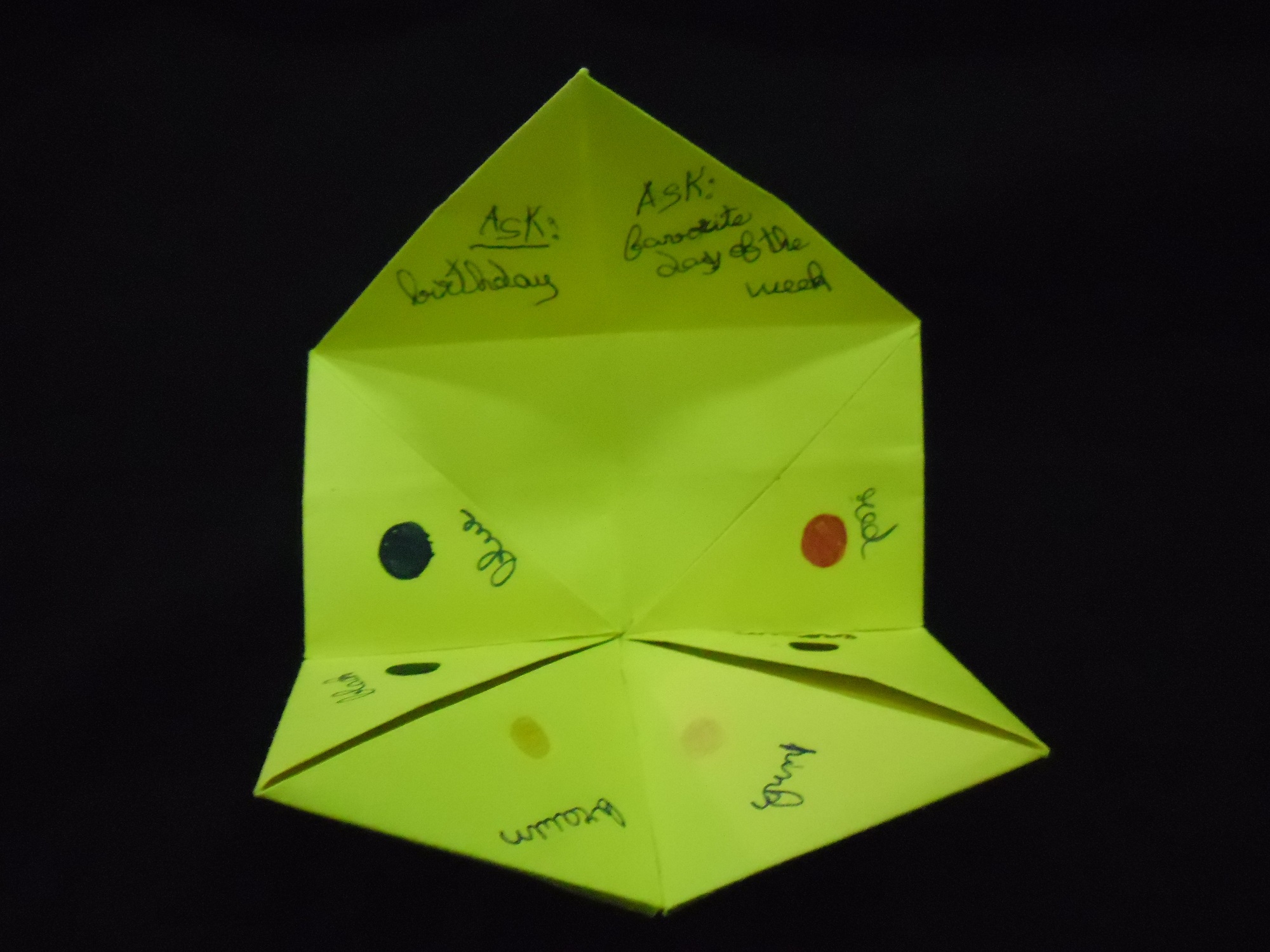

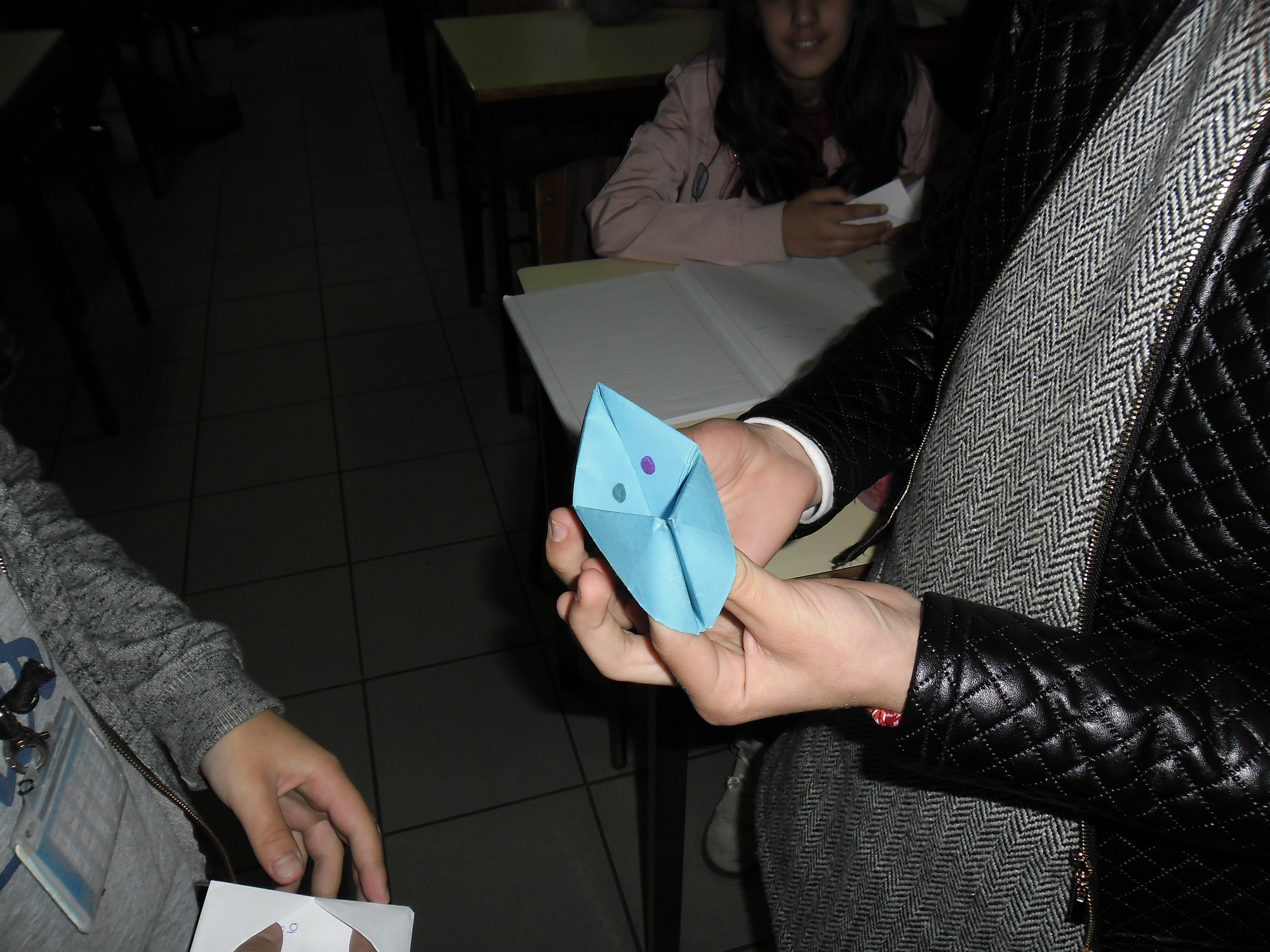
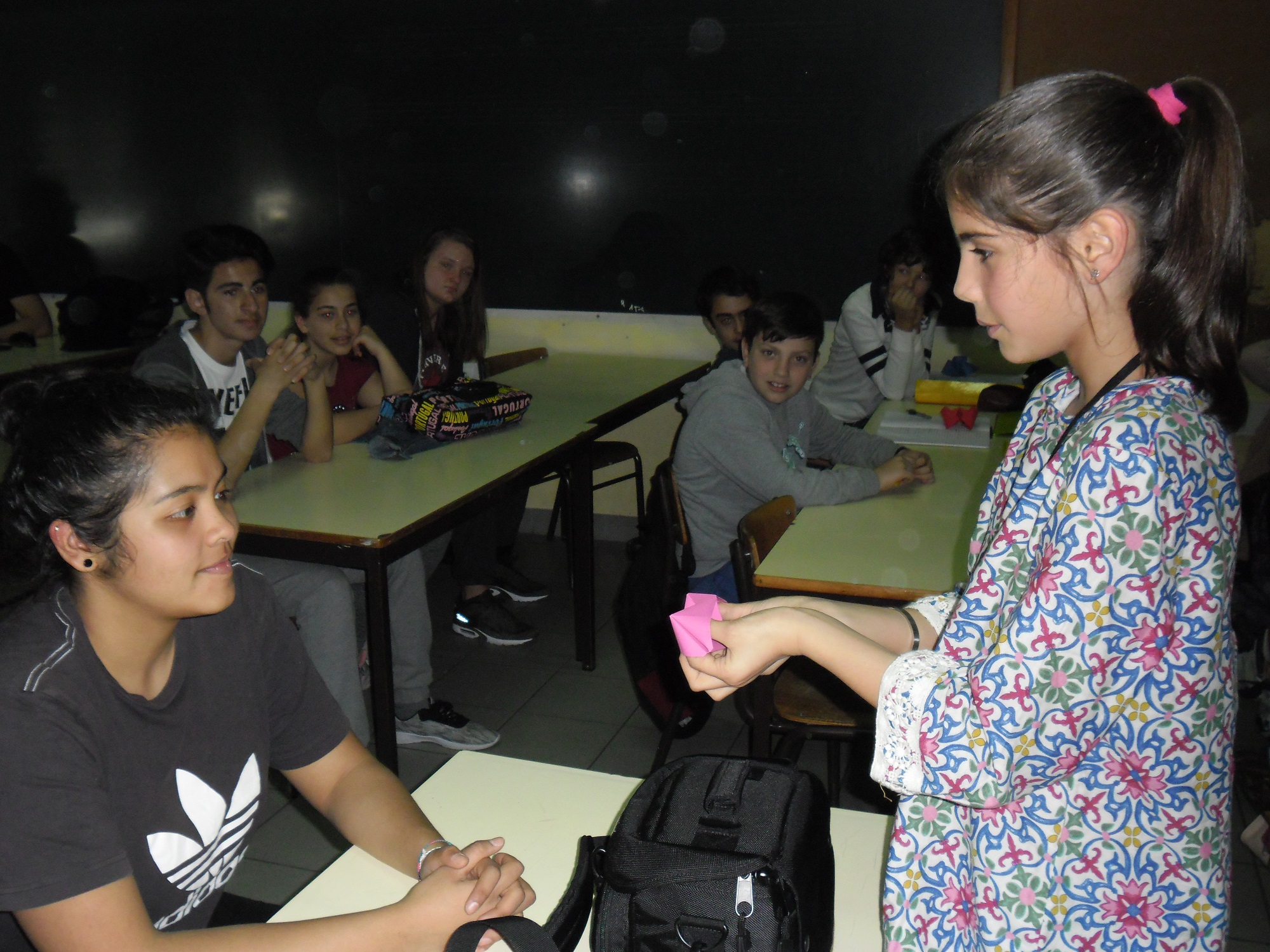

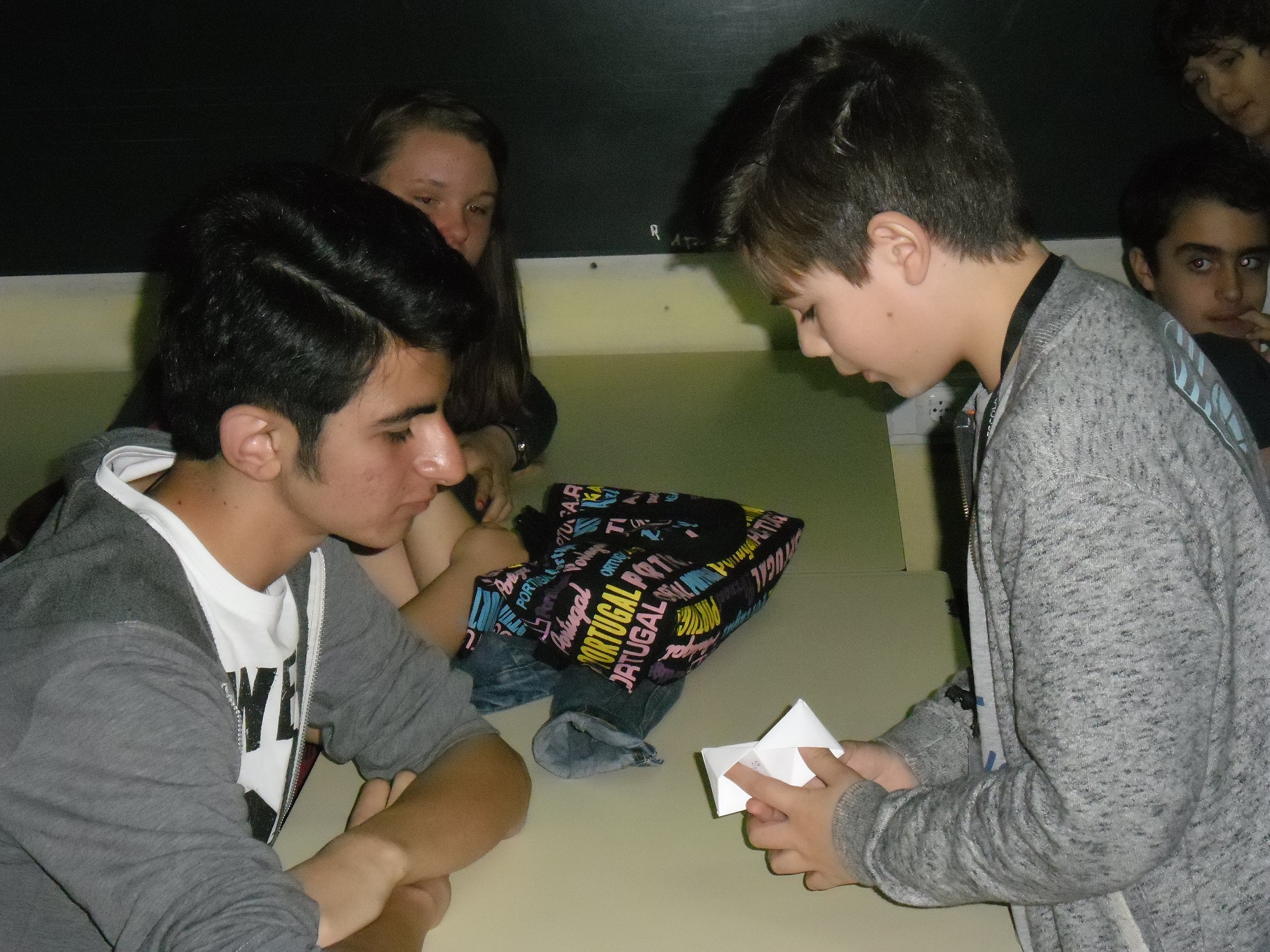

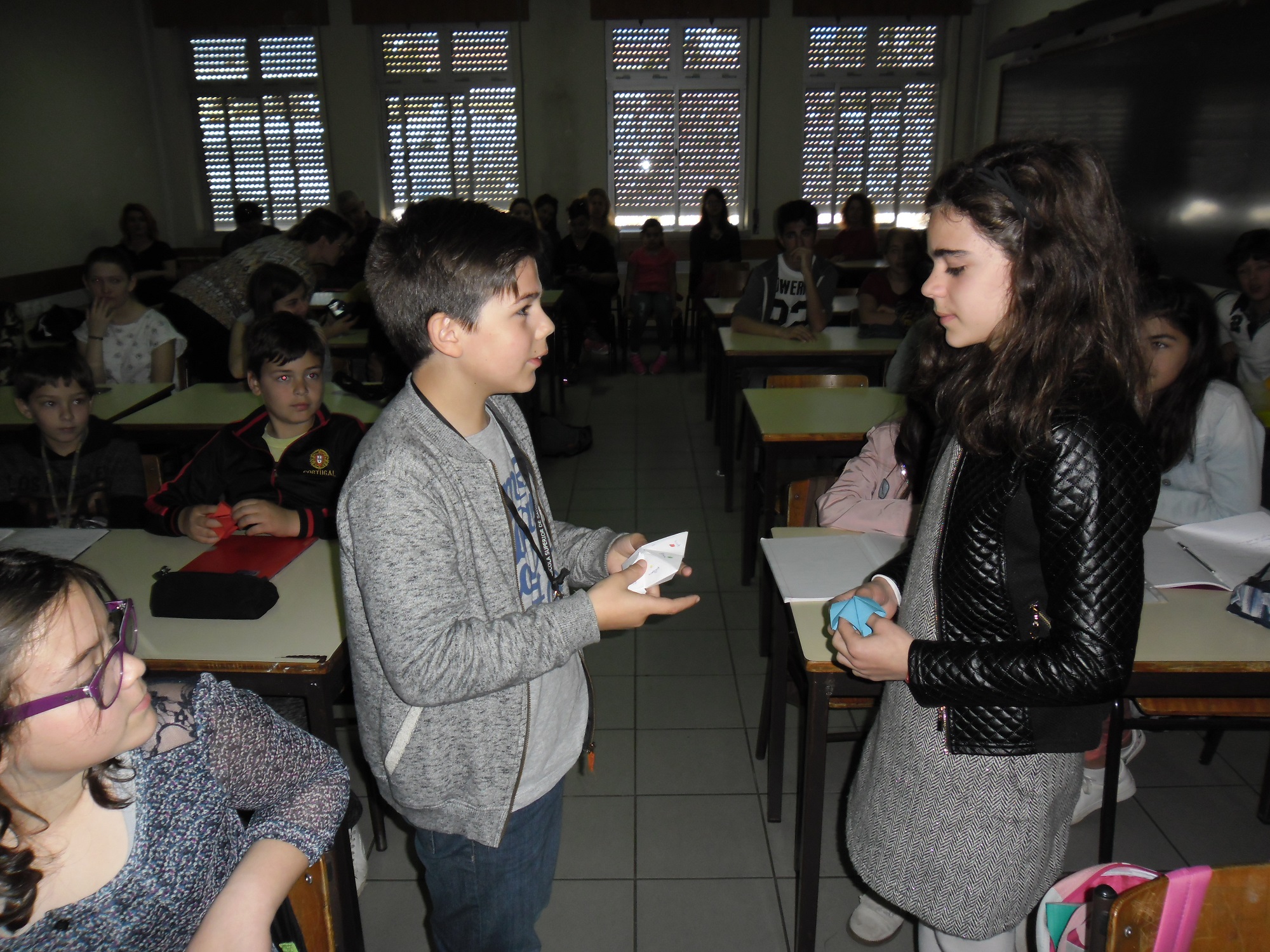
Lessons: Polish Language
Activity title:Revision of the information from "Ann of green gables" by L.M.Montgomery and "That Stranger Boy" by I.Jurgielewiczowa
Grade: 6
Teachers: Anetta Mąkosa, Patrycja Skwira
Aims:
1. Revision of the information from "Ten Obcy" (Eng. "That Stranger Boy") and "Ania z Zielonego Wzgórza" (Eng. "Ann of the Green Gables") books.
2. Practical implementing of the skills taught in lesson.
3. Encouraging co-operation and group work.
The course of the lesson:
1. Dividing students into groups,
2. Presenting the rules of the "Battleships" game by a student taking part in the "Hands in Hands" programme.
3. Teamwork - "Battleships" game.
4. Doing tasks concerning the read books after hitting the enemy's ship.
5. Summing-up. The team that sinks more ships or scores more points wins.
6. Evaluation.
In the lesson we used:
1. "Learningapps" tasks concerning the books "Ten Obcy" and "Ania z Zielonego Wzgórza"
2. Fragments of the movie "Ann of the Green Gables"
3. Prepared "Battleships" materials.
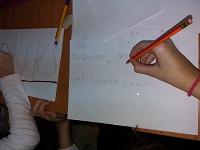

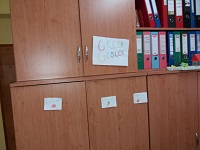



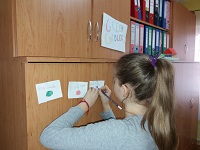

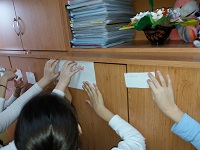
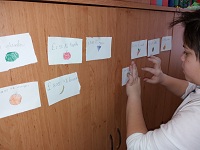
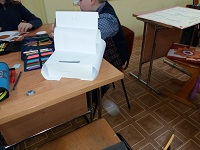

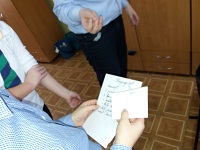


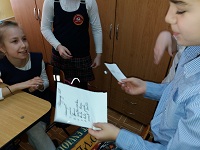
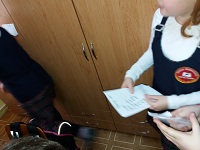
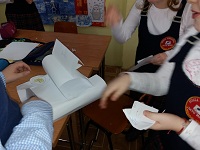
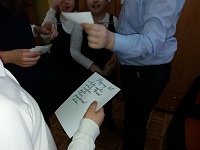
Activity title / generic: Let's go shopping
Methods used:
Communicative Language Teaching
Task-based learning
Community Language Learning
Coordinator: Sorana Bojuc Teodorescu
Date: 28.02 2017
Duration: 2:00
The overall objective: to produce oral messages
Production of written messages
Pedagogical objective: to know the stores and their specific
Become familiar with British currency
communication in real life activity
Ability to develop teamwork
Educational Objective: familiarization with Anglo-Saxon
Description of activity / scenario: students are divided into groups, they “receive” a shop they have to organize it, to " make" products that are sold in their shops, to write a price for each product. Other students are customers who receive a shopping list that they have to follow and "buy" products in the right shops. Students who own shops are receiving customers and sellers usually have dialogue with them.
SWOT analysis: Strengths: Educational attractive
- Using game
- Involvement in activities and pupils with SEN
- The assumption of responsibilities by the majority of students
- Develop the collaboration and communication between members of each group
Weaknesses: High consumption of time to make the necessary materials
- Lack of concentration or lack of involvement of students working with a slower pace
Opportunities: Teamwork
Knowledge base and conduct a specific dialogue
Acquiring knowledge gained confidence and awareness of the utility of knowledge in real life.
Weaknesses: clutter and noise in the preparation of the materials used in the activity.
Suggestions / recommendations / mitigation measures: resume and applying learning games
Short term: return to work in other forms
Long term: carrying out similar activities at times optional.
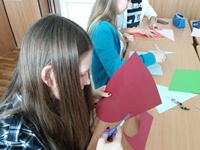
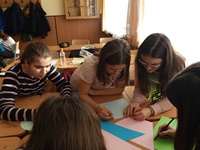

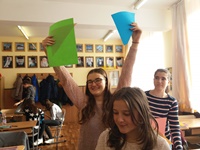
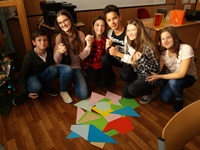
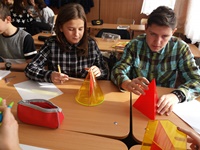
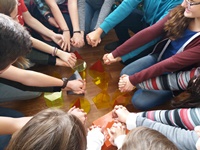

Teacher: Rebic Camelia - Maths
8th graders
Overall objective: Revision of geometrical figures studied
Pedagogical objective: Identifying, properties and calculate areas and volumes
Educational Objective: Develop group responsibilities, teamwork
Description of activity / scenario:
- Divide the group into two teams of students
- Each team receives educational materials work
- It presents work tasks: identifying the elements, presenting their properties, areas and volumes calculation formulas and measurements and comparing the results with approximations
SWOT Analysis:
STRENGTHS: - Teamwork
- Updating theoretical knowledge
- Development of a practical activities
WEAKNESSES: - The high volume of work in a relatively short time
OPPORTUNITIES: - Application of the formulas for calculating theoretical practical activities through measurement
- Training and skills development of self
- Developing team spirit
Threats: - Insufficient involvement of students with slow pace of work and the theoretical gaps
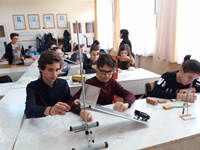



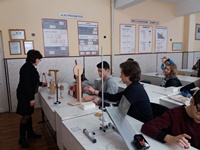
Teacher: Maria Gozar - physics/chemistry
7th graders
Simple mechanisms – revision
Overall Objective: Develop communication skills and teamwork, explain the operation and use of technology products found in everyday life.
Pedagogical objective: development of projects simple presentation, presenting their advantages
Educational goal: practical work skills training, teamwork, personal initiative, interest and curiosity, critical and self-critical, self development and relationship skills
Materials: notebooks, hand levers (balance, pliers, scissors, stapler, etc.) pulley, inclined plane, hooks, notched discs, supports, clips, dynamometers, worksheets
Description of activity / scenario: -it distribute worksheets
- Students working for fulfilling work tasks
- Professor directs the activity, students observe and offer support to those who request
- Complete the worksheet: 1 – 3 groups make poster Lever ; 4-5 groups make poster - Pulley,
and group 6 make poster Inclined plane
- It shows projects created by students and specify their advantages.
- Students evaluate themselves.
SWOT Analysis:
Strengths: Strengths:
- Interest and curiosity
- The assumption of responsibilities by the majority of students
- Develop the collaboration and communication between members of each group
- Use of IT technology in leading the activities
- Developing skills for public presentation of results
- Develop competitive spirit among students
- Tolerance towards the opinions of others
Weaknesses: - High consumption of time to make the necessary materials
- Non-involvement of students working with a slower pace
Opportunities: - Ability to learn new types of applications that develop judgment and logical reasoning
- The computer's usage,
- Conduct by students of similar materials and presentation colleagues
Threats: - Reduced number of hours that can be allocated to such activities
- Free time allocated for the realization of such projects
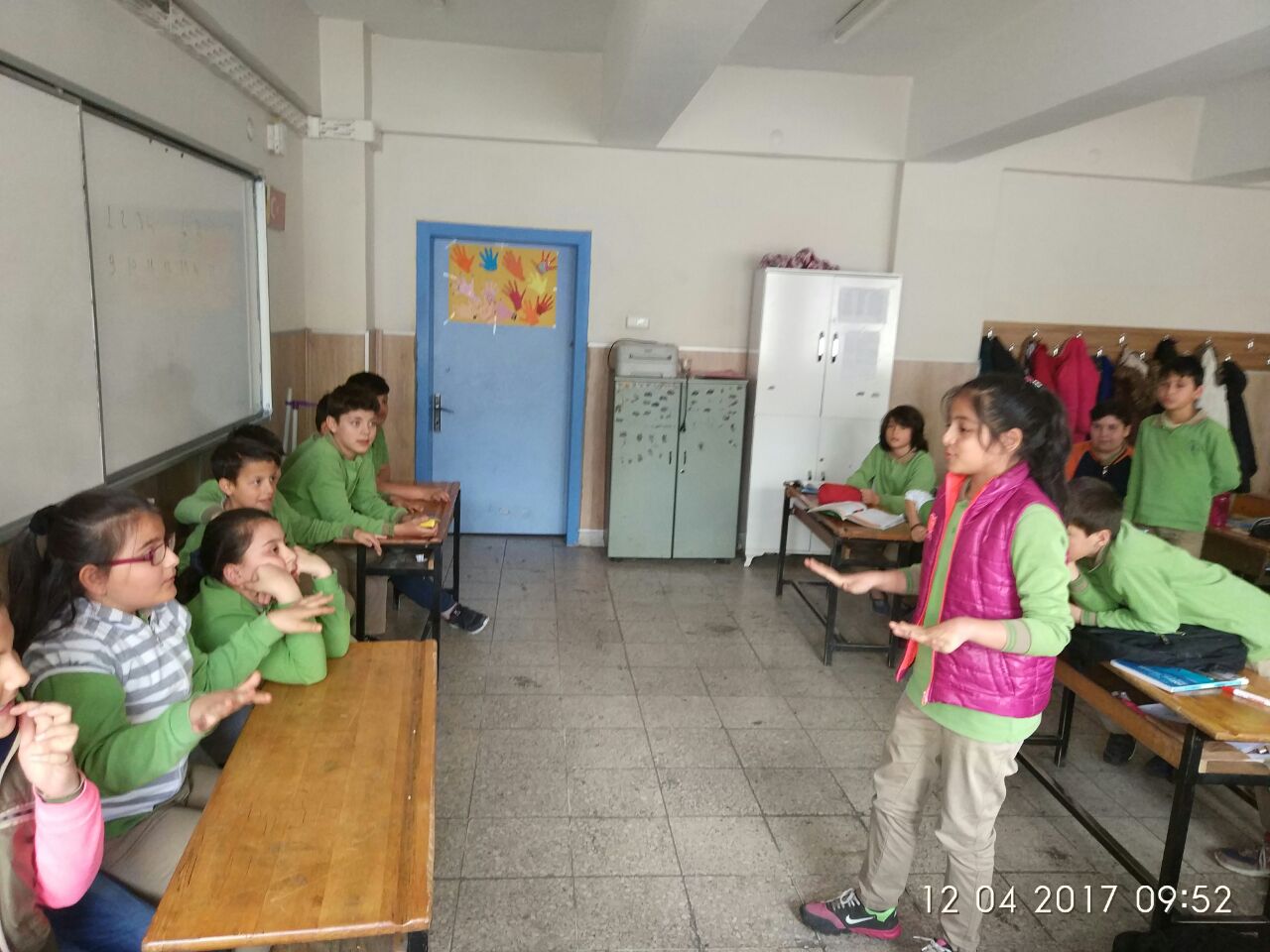
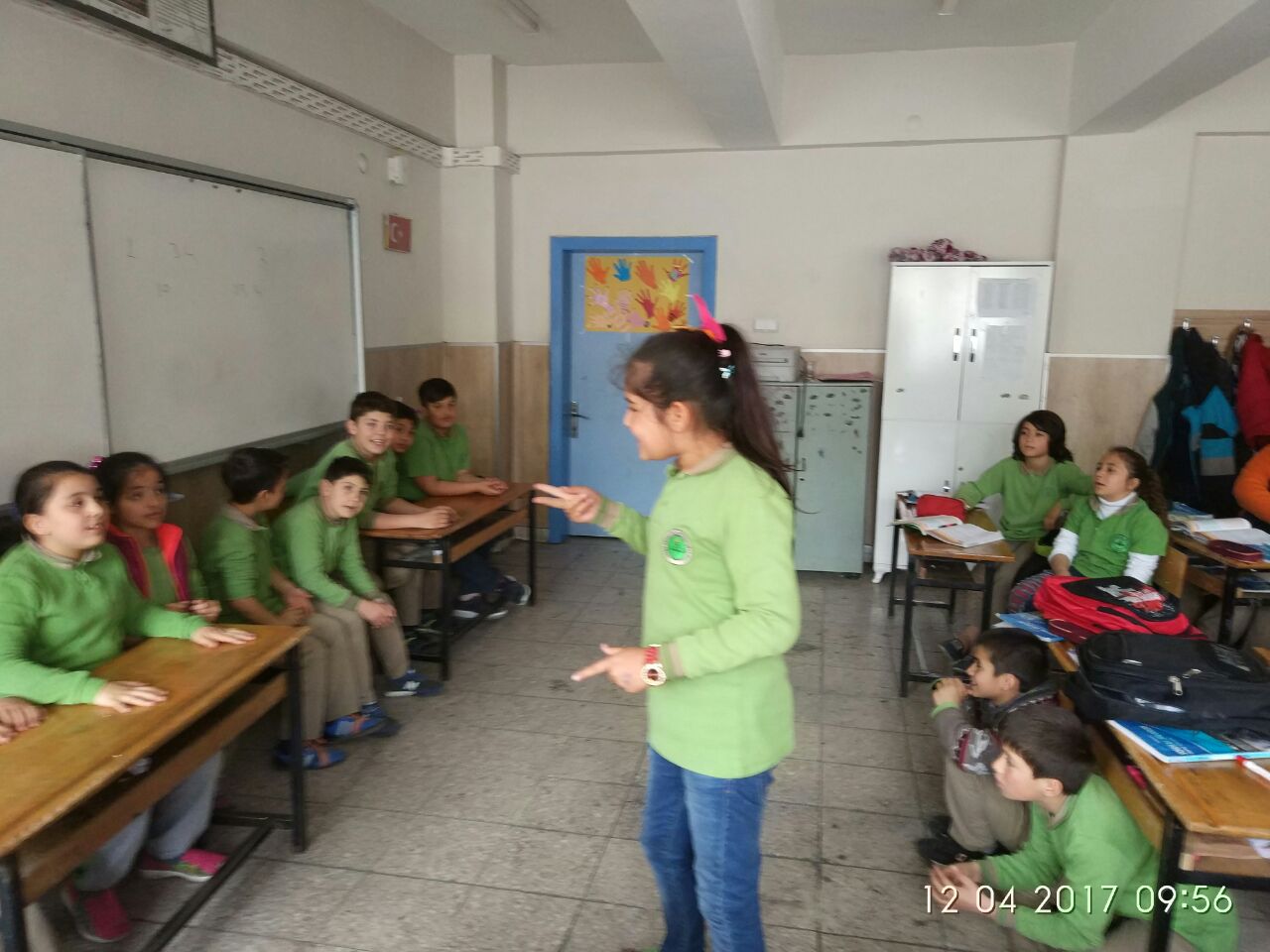

Lesson: Social Studies
Language: Turkish
SOSBU game
Materials: Paper, Pen, Point table
The game has two teams with five groups. Twenty question cards have been created. Each students choose cards in random. And s/he tries to tell what s/he has chosen from cards to his groups without using banned words. If the group knows the question it gets 10 points. The group which has more points is winner.
The aims and the uses of the game:
- To provide comprehansive and complete learning
- To get both visiul and auditory skills
- To make easy revision of the subject
- To make the lesson fun
- To stimulate cruosity
- To stimulate group working
- To improve communication skills
SWOT analysis:
Strenghts:
- Higher curiosity
- Fun lessons
-Group working
Weaknesses:
- Spend a lot of time
- Other students can be bored
Opportunities:
- Easy revision of subjects
- improve communication skills and gestures
Threads:
- Not applicable for all subjects
- winning ambition can give harm to friendship
Subject: Croatian language and English language
Grade: 5th
Teachers: Jelena Buđanec and Žana Lasinović Klarić
Date: 22nd May 2017
Key term: an old Croatian Glagolitic script
Aims: become familiar with the Glagolitic script, stimulate cooperation and teamwork
Application of games:
a) Games: Memory Game- students must match the right question with the right answer. All the answers were previously mentioned in a presentation; The Word Search Puzzle- with the help of the cards with Glagolitic letters students must find certain words; create your name using the Glagolitic script- students are asked to find beads with the Glagolitic letters of their name.
b) Aim of the games: introducing and acquisition of the Glagolitic script, development of attention and concentration, stimulation of cooperation and teamwork
Strategies (procedure): At the beginning of the lesson fellow students get the symbol (Glagolitic letter) at the entrance and they must look for the same sign on desks to find their group. 7th graders present the background of the Glagolitic script through the powerpoint presentation and students must be very careful because the fulfillment of the first assignment depends on their attention. In the Memory Game students must match the right question with the right answers. Afterwards students get cards with Glagolitic letters and with the help of it they should find certain words in the Glagolitic Word Search Puzzle. Words are: friends, hands in hands, etc. Teachers put beads with the Glagolitic letters on the desk and students must find letters of their name. Students keep the beads and do their bracelets.
Methodological note about application of the game: This lesson is a cooperation of the 5th and 7th graders. All the students in upper classes have Glagolitic script in their curriculum of Croatian language. During the lesson we use methods of the presentation, conversation, demonstration, hands-on approach, active learning and learning through games
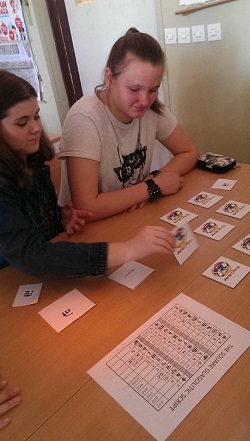
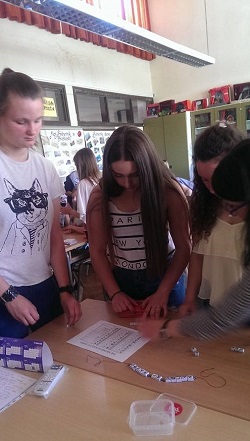

SWOT analysis:
- Strengths: it motivates the students and encourages their interest; it stimulates students’ development of attention and concentration; it develops collaboration and communication between students
- Weaknesses: lack of concentration or lack of students’ involvement
- Opportunities: teamwork; acquiring new knowledge
- Threats: fear of failing the tasks; noise; considerable amount of time used to make the materials
Subject: Maths
Class: Special needs students (in a department there are 6 students: 3 students with autistic spectrum disorders, one of which is non-verbal and two others are partially verbal, 2 students with combined difficulties of low intellectual ability and ADHD, 1 student with low intellectual ability and difficulties with motor skills).
Teacher: Nera Belamarić
Date: Two times a month from October till May
Key terms: numbers from 1 to 6, sets, quantity of the number
Learning aims: understanding definition of the quantity of the number, development of the visual perception and discrimination, stimulation of attention and concentration
Application of game:
Game: Dominoes (dominoes were adjusted to students- big tiles were made from cardboard with the big dots, number of the used tiles was reduced comparing to the original game
Aim of the game: understanding definition of the quantity of the number, development of the visual perception and discrimination, stimulation of attention and concentration
Strategies/procedure: At the beginning of a lesson we demonstrate a game to students and explain the rules. We help student to divide tiles correctly. With the help of the teacher and assistant, they play the game. During the play students need constant guidance (count the dots, which number we are looking for, look at your tiles, search the number you need, etc.). Provide physical help if needed. Remind the students to follow order and rules of the game. When one student wins encourage others to award him/her with applause and in that way stimulate development of the correct behavior. At the end of the lesson all the students get recognition and an award (e.g. chocolate, candy) for taking part in the game.
Methodological note about application of the game: Game is used as a separate lesson, i.e. the lesson of exercise and revision of the definition and quantity of the number. During the lesson we use methods of the oral presentation, conversation, demonstration and hands-on approach.
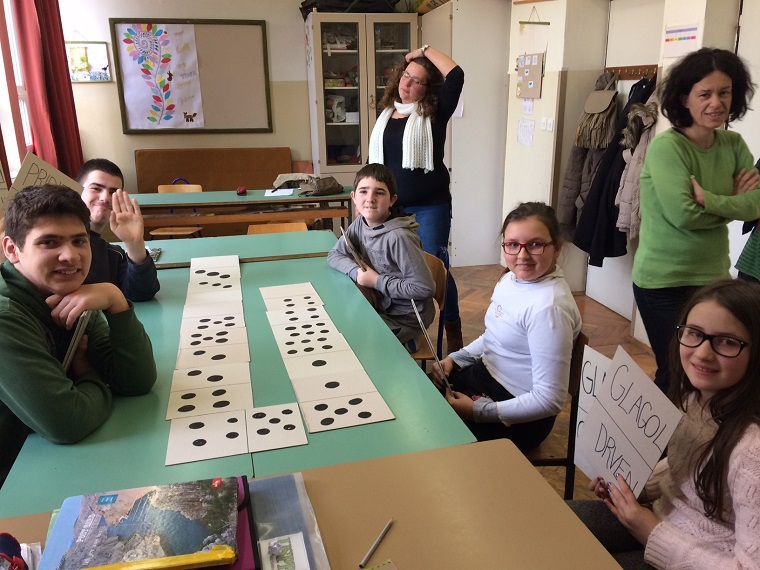
SWOT analysis:
- Strengths: stimulation of the visual perception and discrimination, attention and concentration of the students
- Weaknesses: since it is an individual game, it doesn’t encourage the mutual communication and socialization of the students
- Opportunities: it stimulates development of the acceptable behaviour of the students (students have to congratulate the competitors for winning the game
- Threats: showing the unacceptable behavior if some other student wins
Subject: Croatian language
Class: Special needs students (in a department there are 6 students: 3 students with autistic spectrum disorders, one of which is non-verbal and two others are partially verbal, 2 students with combined difficulties of low intellectual ability and ADHD,1 student with low intellectual ability and difficulties with motor skills).
Teacher: Nera Belamarić
Date: Two times a month from October till May
Key terms: nouns, verbs, adjectives
Learning aims: recognize and differ word classes (nouns, verbs, adjectives)
Application of game:
a) Game: "Staple” – big cardboard cards are divided in two fields (in one field there is a word, e.g.- a house and in the other field there is a word class, e.g.- an adjective). Students have to match the cards in the appropriate way (for the easier understanding and managing a game we use the rules of dominoes), e.g. a word house should be connected to the field- noun and the word class adjective to a word yellow
b) Aim of the game: recognize, differ and connect words and word classes, reading practice, stimulate the development of attention and concentration.
Strategies (procedure): At the beginning of the lesson we repeat types of words (the ones they learned). We demonstrate a game to students and through demonstration we explain them the rules of the game. Help the students in a regular division of cards. With the help of the teachers and assistants students play the game. During a game it is necessary to guide the students (read what you are looking for, what word class does a word to sleep belog to, look for the solution in your cards, etc.). Provide physical help if needed. Remind the students to follow order and rules of the game. When one student wins encourage others to award him/her with applause and in that way stimulate development of the correct behavior. At the end of the lesson all students get recognition and award (e.g. chocolate, candy) for taking part in the game.
Methodological note about application of the game: Game is used as a separate lesson, i.e. the class of exercise and revision of the word classes. During the lesson we use methods of the oral presentation, conversation, demonstration and hands-on approach.
SWOT analysis:
- Strengths: it stimulates students’ attention development and concentration
- Weaknesses: since students need a lot of guidance it doesn’t encourage their independence
- Opportunities: it stimulates development of the acceptable behavior of the students (applauding when the answer is correct, students have to congratulate the competitors for winning the game)
- Threats: showing the unacceptable types of behavior if the answer is incorrect or some other student wins
Subject: Science and Social Studies
Class: Special needs students from the 1st till the 8th grade (all together 10 students)
Teachers: Nera Belamarić and Hana Cvitanović
Date: 24th May 2017
Key terms: Project “Hands in Hands”- flags of the partners’ countries
Learning aims: familiarize students with the flags of Croatia, Germany, Turkey, Poland, Romania and Portugal
Application of game:
a) Game: "Flags"- each student gets 2 pieces of collage paper. On one side of the collage paper there is a question and students need to answer it correctly, find the answer on the hammer paper and stick that piece of collage paper at the place of the answer. When all the students stick all the pieces of collage paper, they get the flags of the project member countries flags.
b) Aim of the game: revision and exercise of the teaching matter from the Science and Social Studies, familiarization of the students with the project members countries and their flags, development of attention and concentration, development of motor skills
Strategies (procedure): At the beginning of the lesson we welcome the guests and encourage our students to introduce themselves. We demonstrate a game and through demonstration we explain the rules to the students. We give pieces of collage paper to our students. Students who are able do their task independently and the rest of them provide and find correct answer and stick the collage with the help of the teacher. When one of the students provides a correct answer we encourage others to award him/her with applause and in that way we stimulate development of the correct behaviour. When students get a certain flag on the hammer paper we introduce them with the name of the country that flag belongs to. At the end of the lesson we revise the flags and countries and award the students with the praise and applause for taking part in a game and for successful execution of the task.
Methodological note about application of the game: Game is used as a separate lesson, i.e. the workshop class as a part of the “Hands in Hands” project. During the game we use previously learned and adopted content from the Science and Social Studies and the questions were prepared in advance for each student. For the student who are non-verbal or are partially verbal we use pictures (e.g. find the picture of the train). During the lesson we use methods of the oral presentation, conversation, demonstration and hands-on approach
SWOT analysis:
- Strengths: it motivates the students and encourages their interest because they don’t know the final outcome of the game; it stimulates students’ attention development and concentration
- Weaknesses: /
- Opportunities: stimulate development of the acceptable behaviour of the students (applauding when the answer is correct), helping the colleague
- Threats: rejection of the participation because of the big number of participants, fear of failing the tasks
Subject: Croatian language and religious education
Grade: 6th
Teachers: Nataša Jurić Stanković, Andrea Cinotti
Date: 22nd May 2017
Key term: Šibenik
Aims: introduce students with our town Šibenik, stimulate cooperation, creativity and teamwork
Application of games:
- Games: „Calling“, „The drum is calling“, „Meet Šibenik!“ and „Knot“
- Aim of the games: introducing our town Šibenik, stimulation of cooperation, creativity and teamwork
Strategies (procedure):
1. Entrance: Students get paper with one of the letters: Š, I, B, E, N, I, K . Letters are on desks and students divide accordingly into the 6 groups of 4-5 students.
2. Motivation for work:
- game “Calling“: students stand in a circle and are calling students on the other side. Strength of the voice can go from whisper to shouting. Students can also make some gestures of calling.
- game „The drum is calling“: everybody is doing one movement together at the same time. There are 4 basic moves: tap your thighs, clap, snap the fingers on your right hand and snap the fingers on your left hand. Everybody is moving in the rhythm of tapping- clapping- snapping until the host says (in the rhythm) „Are you ready? Let's go!“ and with the first snapping she says her name and with the second snapping, the name of her playmate, for example: tapping-clapping- Ivan - Petar. Petar imediately continuous with tapping-clapping- Petar- Sofija (Sofija- tapping-clapping- Sofija- Marko) etc. Everything has to be in rhythm. When the tempo gets faster, it gets harder. The student who makes a mistake, gets out of the game.
3. Working in groups
Introducing Šibenik
a)
- brainstorming: fellow students are writing words that remind them of Šibenik
- reading and commenting
b)
Afterwards, students watch a movie about Šibenik:
https://www.youtube.com/watch?v=mDyRDOX4FrQ
https://www.youtube.com/watch?v=FKoMtYc9ytw
c)
Next is PowerPoint presentation about churches in the old town of Šibenik.
d)
After expressing all the impressions, students in groups get texts of the poems about Šibenik (translated into English language) Šibenik is a town by the sea, written by the Croatian poet Jakša Fiamengo (in the attachment)
- extraction of the key words
- reading of the key words
4. PLAYING THE GAME „Meet Šibenik!“
Students of the primary school Petra Krešimira IV. have created a board game „Meet Šibenik!“ with the tasks in which players move through the streets of the old town Šibenika and visiting cultural and historical sights. They throw a die and once they come to a certain field, they raise a card with awards or punishments. They must do what the card says in order to move further. The winner is the player who does a circle around the old town and comes first to the end.
Fellow students got this board game as a souvenir from this class.
5. Creation of the poem about Šibenik
In groups, students write diamante (diamond) poems in English language according to the given form (attachment 2)
6. The final game
-game „Knot“ in two groups: each student catches left hand of his team mate with his left hand and right hand of some other team mate with his right hand. Their task is to untangle the knot without releasing the hands of the team mates. This game emphasise cooperation in the group, as well as socialization and creativity.
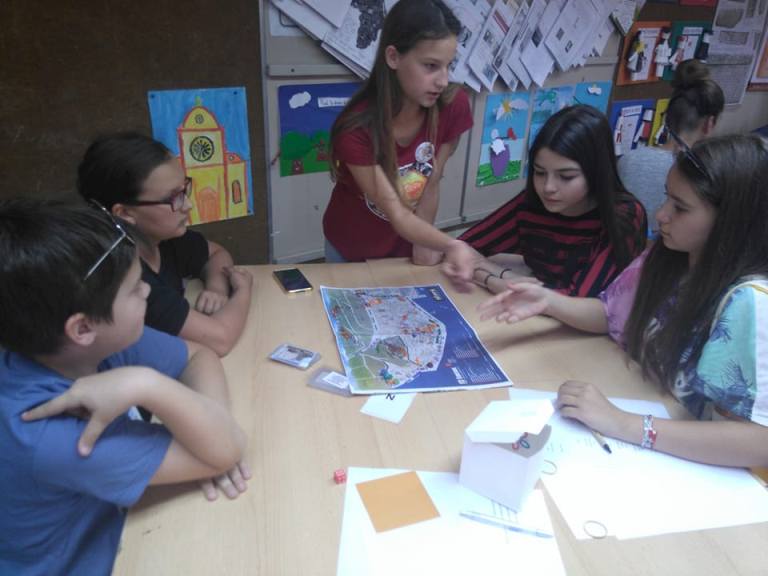
BOARD GAMES IN CROATIAN LANGUAGE CLASSES
In Croatia, once a month, students are obligated to read assigned books from Croatian and world literature. We can't say that reading and analyzing novels and stories is students' favourite thing, so we need to familiarize them with literature through different and interesting ways of elaboration.
Instead of the boring analysis of literary work, students got some interesting tasks:
- make a board game with the theme of a certain novel
- paint a paper bag with the title of a novel and put some objects that charachterize main character ( with the instruction manual)
- make Facebook profile of the main character (in a Facebook programme)
- make a picture-book that will shortly retell and paint the literary work
- make newspaper that will contain pictures and articles connected with the characters and events in the book.
Grade: 7th
Teachers: Nataša Jurić Stanković
Date: January 2018
Key term: social novel
So for the novel Oliver Twist written by Charlesa Dickens pupils made different board games modeled on the existing ones ( Ludo; Monopoly , etc.), and they can be seen in the pictures. Pupils played games with the rest of their classmates during the Croatian language class.
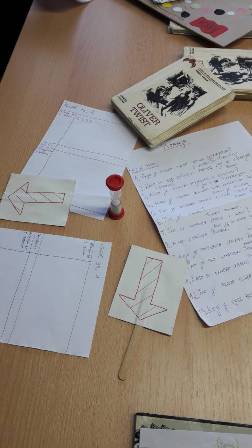
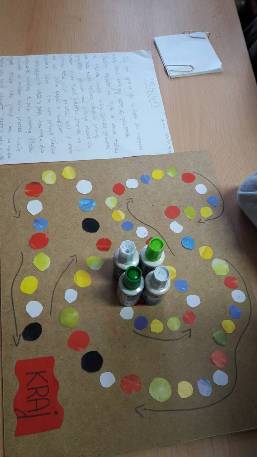
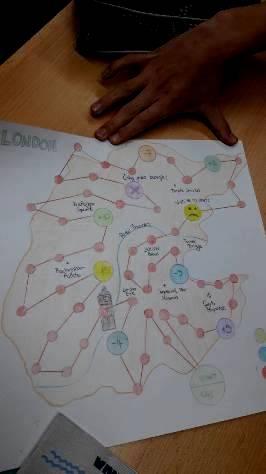
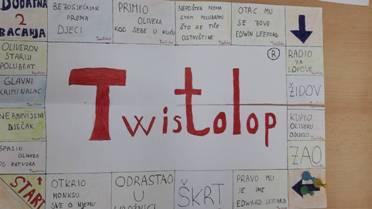
Some pupils painted paper bags and presented the character of Oliver Twist with the objects he might need: a scarf, a cap, an apple, a book…
Grade: 7th
Students presented the novel In Desert and Wilderness by Henryk Sienkiewicz
with the newspaper where they wrote a travel book from the african regions where the main character Stas and Nel travel, the historic display of Africa in the 19th century, an interview with the main characters and news from that time. The other class got the same task but they got the novel The Prince and the Pauper by Mark Twain. Newspaper had to have an interview with the characters of Prince Edward and poor pauper Tom Canty, data about London in the 16th century, invented news from that period , etc.
Croatian novel about Mijat Tomić, the hero from our past, was presented by the 6th grade pupils through a picture-book.
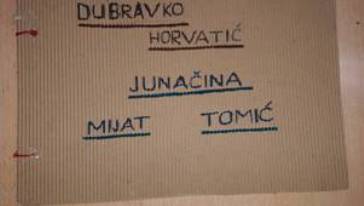
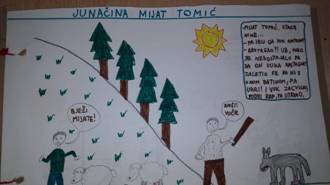

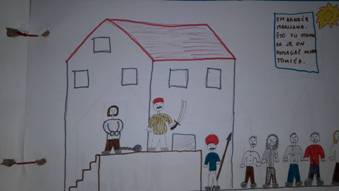
FAIRY TALE AS A PUPPET- SHOW
Croatian fairy tale The Little Fairy is a very sad story about a little fairy who was in love with the prince and because of his love she grew up to the normal height. However,the prince forgot about his promise to love her forever and he found a new girlfriend. A sad fairy got little again and disappeared.
After the elaboration of this fairy tale in the class, 5th grade pupils got the assignment to make a dramatization in groups, make puppets together and show the play.
Class project called The Puppet Fairytale lasted for 15 days. Pupils made very imaginative puppets, scenography and they performed their plays. The rest of the puplis evaluated the quality of the dramatization, making of the puppets and scenography, performance and group work.
With this correlation between two teaching areas was accomplished: literature and media culture. (In Croatia the subject Croatian language has five areas: language, literature,reading, language expression (oral and written) and media culture.)

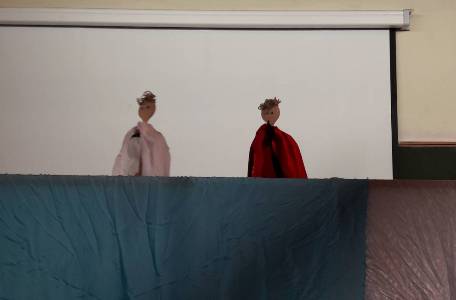
At the video you can see some of the performances.
Ouri Game - Maths
Subject: Mathematics
Grade: 7th
Teacher: Elisabete Almeida
Date: April 24th, 2018
Summary: Ouri Game
Learning Objectives: Develop reasoning and calculation.
Strategies / procedure:
Preparation: The teacher divides the class into groups of two players. Next, she shows the students the game while giving them it’s historical background. Then she explains and projects the rules of the game.
The game is based on the transfer principle. It is made for two people and played on a board of 12 houses with 48 seeds. This game, apparently simple, requires reflection, calculation and lots of practice. It is necessary to know, of course, the various hypotheses offered in each move, as well as predict the opponent's attacks. Therefore, this game is considered an expert or scholar games.
The Mancala games are known by a wide variety of names and rules (ex. Ouri, Ouril, Ori, Urim, Awari, Warri, Agi, Awèlé, among others), especially in regard to those practiced/played in Africa and America.
The objective of the game is to collect more pieces than the opponent, thus winning the player who gets 25 pieces or more. Only when the last stone thrown on the side of the enemy and in that house already exists 2 or 3 stones, they can be collected. In this case, all stones in previous houses are collected as long there are 2 or 3 stones.
SWOT ANALYSIS:
Strong points:
The Ouri picks interest and increases student activity in Mathematics. In addition, it combines reasoning, strategy and reflection, with challenge and competition in a playful atmosphere, developing the capability to formalize strategies, memorize and increase personal and social development.
Opportunities:
Integration of all students in the activity.
Threats:
There are none.
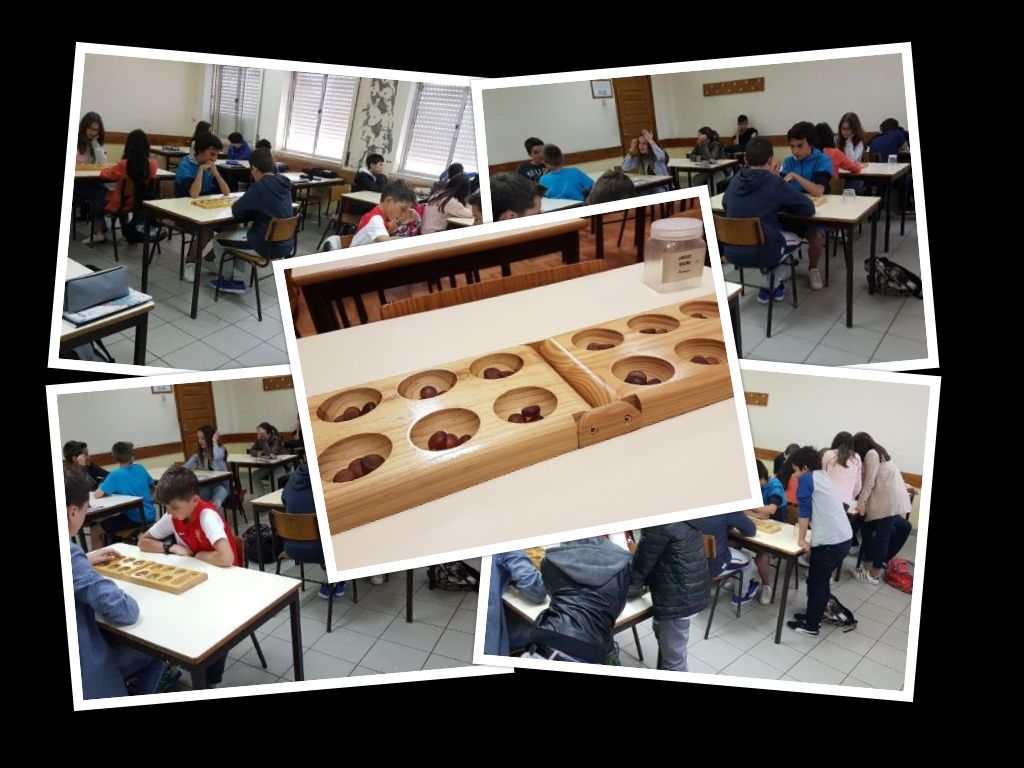
Subject: Croatian language and English language
Grade: 6th
Teachers: Jelena Buđanec and Žana Lasinović Klarić
Date: 22nd February 2018
Key term: Past Simple Tense
Aims: practice Past Simple Tense, revise regular and irregular verbs, stimulate cooperation and teamwork
Application of games:
a) Games: Cards with the verbs in infinitive and in Past Simple- students must match the right infinitives and verbs in Past Simple (in Croatian and English).When they find each other they must hold hands and form groups of four pupils. Board game- students play a handmade board game and answer the questions when they come to brown fields.
b) Aim of the games: revision of the Past Simple Tense, development of attention and concentration, stimulation of cooperation and teamwork
Strategies (procedure): At the beginning of the lesson students get cards with the verbs in infinitive and past simple (in Croatian and English). Students stand up and look for the classmates that have the same verb. They hold their hands and form a group. Teachers prepare more cards with different subjects, objects, adverbials, etc. and put them at the blackboard. Students have to choose cards and make correct sentences using the verbs in past simple. Afterwards they have to transform their sentence into the negative form and form of the question (both in Croatian and English). Next stage is writing a short story using the sentence they got in any of the forms. Students read their stories and other classmates are active listeners. At the end of the lesson we revise the Past Simple Tense through the questions that students have to answer if they stop at the certain fields while playing handmade board game.
Methodological note about application of the game: This lesson is a cooperation and correlation between Croatian language and English language classes. During the lesson we use methods of the conversation, demonstration, writing, reading, listening, active learning and learning through games
SWOT analysis:
- Strengths: using games; educational attractive; it improves many different skills; it stimulates students’ development of attention and concentration; it develops collaboration and communication between students
- Weaknesses: lack of concentration or lack of students’ involvement
- Opportunities: teamwork; improving their knowledge
- Threats: fear of failing the tasks; noise